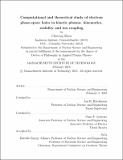| dc.contributor.advisor | Ian H. Hutchinson. | en_US |
| dc.contributor.author | Zhou, Chuteng | en_US |
| dc.contributor.other | Massachusetts Institute of Technology. Department of Nuclear Science and Engineering. | en_US |
| dc.date.accessioned | 2018-11-15T15:52:07Z | |
| dc.date.available | 2018-11-15T15:52:07Z | |
| dc.date.copyright | 2018 | en_US |
| dc.date.issued | 2018 | en_US |
| dc.identifier.uri | http://hdl.handle.net/1721.1/119039 | |
| dc.description | Thesis: Ph. D. in Applied Plasma Physics, Massachusetts Institute of Technology, Department of Nuclear Science and Engineering, 2018. | en_US |
| dc.description | This electronic version was submitted by the student author. The certified thesis is available in the Institute Archives and Special Collections. | en_US |
| dc.description | Cataloged from student-submitted PDF version of thesis. | en_US |
| dc.description | Includes bibliographical references (pages 181-191). | en_US |
| dc.description.abstract | In this thesis, a comprehensive study of Bernstein-Greene-Kruskal (BGK) mode electron holes in a collisionless plasma where strong kinetic effects are important is presented. Kinematic theory based on momentum conservation is derived treating the electron hole as a composite object to study the dynamics of electron holes. A novel 1-D Particle-In-Cell simulation code that can self-consistently track the electron hole motion has been developed for the purpose of this thesis work. Quantitative agreement is achieved between analytic theory and simulation observations. The thesis reports a new kind of instability for electron holes. Slow electron holes traveling slower than a few times the cold ion sound speed in the ion frame are observed to be unstable to the oscillatory velocity instability. A complete theoretical treatment for the instability is presented in this thesis. Numerical simulations yield quantitative agreement with the analytic theory in instability thresholds, frequencies and partially in instability growth rates. It is further shown that an electron hole can form a stable Coupled Hole Soliton (CHS) pair with an ion-acoustic soliton. A stable CHS travels slightly faster than the ion-acoustic velocity in the ion frame and is separated from a typical BGK mode electron hole in the velocity range by a gap, which is set by the oscillatory velocity instability. Transition between the two states is possible in both directions. A CHS exhibits a soliton-like behavior. The thesis sheds light on solving the ambiguity between an electron hole and a soliton. This thesis work also has important implications for interpreting space probes observations. | en_US |
| dc.description.statementofresponsibility | by Chuteng Zhou. | en_US |
| dc.format.extent | 191 pages | en_US |
| dc.language.iso | eng | en_US |
| dc.publisher | Massachusetts Institute of Technology | en_US |
| dc.rights | MIT theses are protected by copyright. They may be viewed, downloaded, or printed from this source but further reproduction or distribution in any format is prohibited without written permission. | en_US |
| dc.rights.uri | http://dspace.mit.edu/handle/1721.1/7582 | en_US |
| dc.subject | Nuclear Science and Engineering. | en_US |
| dc.title | Computational and theoretical study of electron phase-space holes in kinetic plasma: kinematics, stability and ion coupling | en_US |
| dc.type | Thesis | en_US |
| dc.description.degree | Ph. D. in Applied Plasma Physics | en_US |
| dc.contributor.department | Massachusetts Institute of Technology. Department of Nuclear Science and Engineering | |
| dc.identifier.oclc | 1059514973 | en_US |
